I’m not a frequent Amiga party-goer. I had my fair share when I was younger, but I no longer see much point in going to far-away places only to find, typically, a dozen tables with old machines running old games. So the Amiga37 party announcement in April left me somewhat indifferent, all the more so when I realized that the venue was located over a thousand kilometres from my hometown. However, I began to have second thoughts when it became clear that it was going to be the largest Amiga gathering in years, and when many of my online friends have confirmed their attendance. The actual moment of decision came with me learning about the Setpatch Aftershow Party, which was supposed to round off the Amiga37 with live performances of the legendary Chris Hülsbeck and of the Norwegian cover band FastLoaders. With the latter featuring in the line-up, I knew it would only take a single phone call to persuade my old pal Human Factor to take me there in his car: on top of being Amiga addicts we’re both huge FastLoaders fans!
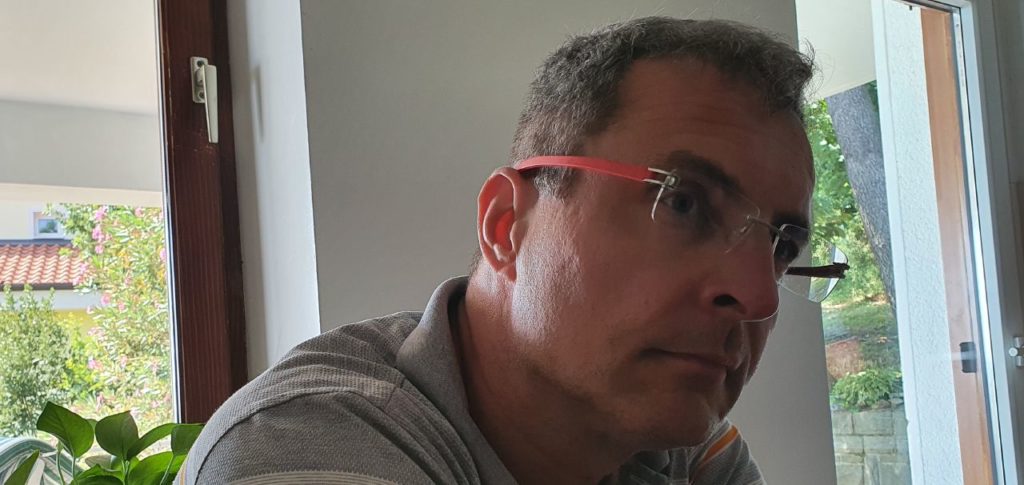
On Friday 14 October, we set off in the morning because Human Factor had estimated the journey to take pretty much the whole day. We made regular stops every two hours or so, to recharge the car and to take a rest, which became increasingly necessary as we progressed towards our destination. Well into the German territory, we stopped at downtown Kassel for a late lunch, and had a lot of fun in a local restaurant called Alex. I was in the mood for some craft beer and had one recommended, only to find strawberries floating in the glass as the waiter proudly served it. An adventurous drink to say the least! I had barely fished out the poor drowning fruit when our meals were brough and we had to bite our lips again, seeing that Human Factor’s bowl of spaghetti was covered by two unsolicited Wiener schnitzels the size of my hand! But the meal was delicious and my chicken curry came with no further surprises, so we left the Alex as satisfied customers with bellies full to the brim.
The clock was chiming 10pm when we finally arrived in Mönchengladbach and checked in at the T3 Cityloft Hotel. The receptionist on night duty couldn’t help raising his eyebrows when, instead of our accommodation and sightseeing opportunities, we rather inquired about a pub nearby that might still be serving draught beer at this hour. But that’s what you get when you send Czechs abroad: we’re a beer-drinking nation, and we’ll always be the first to admit it.
In the morning, after breakfast that either was mediocre or we were still hung over (I couldn’t tell), we called a taxi to take us to the Amiga37 venue. The Kunstwerk was located about five kilometres from the hotel, so we were there in no time and happily joined the registration queue. After a moment we realized that the two guys queuing right in front of us who looked like Dave Haynie and Ron Nicholson of Commodore were indeed Dave Haynie and Ron Nicholson of Commodore, so it was clear that the show was going to be big.
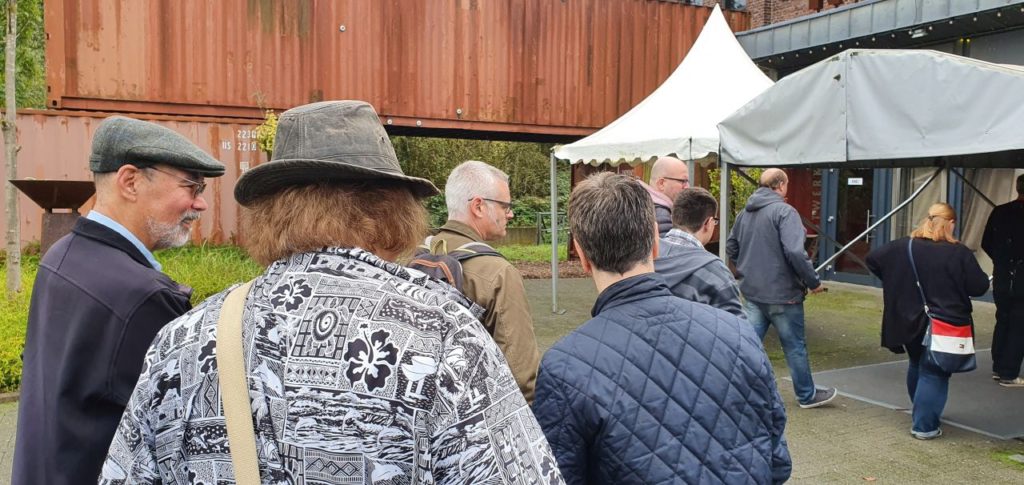
The registration didn’t take long and soon we found ourselves in, wearing stylish red wristbands indicating that we were respectable paying members of the International Amiga Brotherhood. We also received a free copy of the Amiga Future magazine, a special issue dedicated to the event. Although just a few minutes past 10am, the large hall of the Kunstwerk was already fully occupied with tables showing various Amiga as well as non-Amiga hardware. We really didn’t know where to start, so we started at the bar.
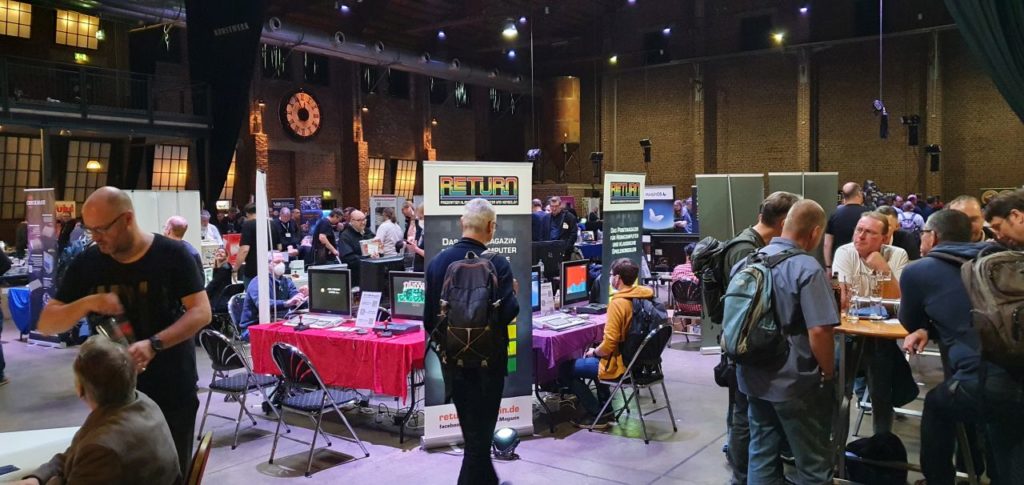
Upstairs above the hall, in a section called The Red Crocodile (Rotes Krokodil), interviews were held throughout the day featuring various Amiga luminaries past and present. The Crocodile was a very nice place, with a posh red leather sofa and armchairs on the stage. According to the schedule, David Pleasance formerly of Commodore UK was supposed to speak at eleven, but when we took our seats the man was nowhere to be seen. After a few minutes it became obvious that he wasn’t coming, also because the table down in the hall where he was supposed to promote his books was still empty. So we continued exploring the hall. I spent a few minutes at the table right next to David’s, where the director Steven Fletcher was stationed selling his documentary films and other stuff.
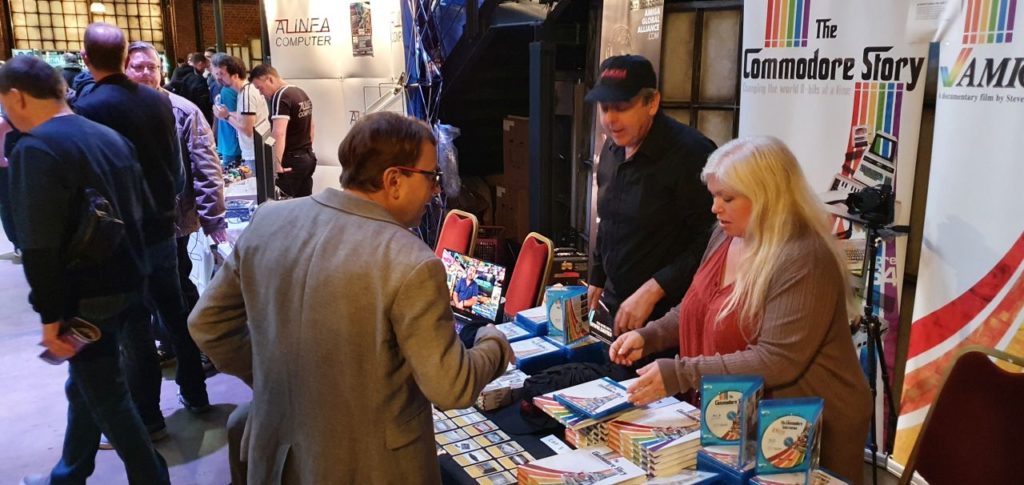
I had briefly met Steven at the 2017 Amiga Developer Conference in Cardiff, where he was filming material for The Commodore Story. Having seen this feature documentary two months previously, I wanted to say hello and well done to the very man who had made it. Steven told me he’d recently finished a new film, Amiga: Alive and Kicking, which he also had for sale on the table. The deal was sealed and I ended up buying three films on BluRay, plus a book that accompanies the Commodore Story film. We had a funny moment when I found myself in a photo as I was browsing through the book; Steven said that my face did look familiar but he had no idea he was talking to one of his impromptu “actors”!

Lunchtime approached and David Pleasance appeared in the hall; we felt lucky that his talk had only been postponed rather than cancelled. Unfortunately, as we were told by one of the organizers, he wasn’t going to share his Commodore-time stories but present his latest project, the so-called Commodore Amiga Global Alliance. Having mixed feelings about it we eventually decided to give the presentation a miss, and instead we popped into a nearby restaurant to have a small lunch and a few pints. The place served a decent lager called Bitburger – as computer freaks we found the name very appropriate, and even proposed a few Limited Edition variants such as the 8-Bitburger and the more powerful 16-Bitburger.
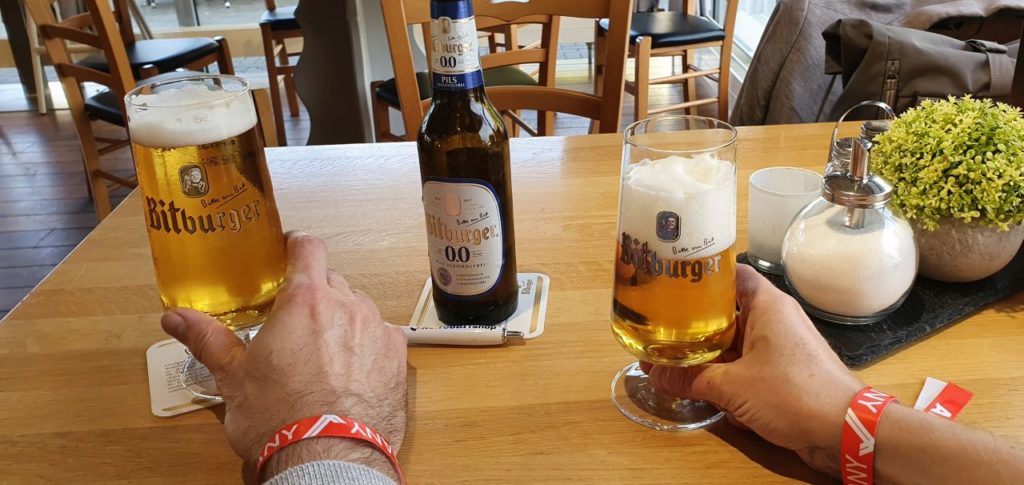
When we returned, the hall had noticeably more visitors and the event was in full swing. I visited the combined AAA stand to say hello to AmigaKit owner Matthew Leaman, and saw that they had two AmigaOne X5000 computers on display running various AmigaOS4 (and later also MorphOS) stuff. Compared to that, the ACube table located nearby looked much more static and, frankly speaking, left a lot to be desired. Considering that ACube currently has two OS4-compatible hardware models in the works (the Sam460LE and the A1222), I expected a vibrant presentation with several computers offering hands-on experience, in order to lure prospective buyers. But that didn’t happen. When I came over, ACube’s representative was just standing there looking at a few disconnected PCBs. Later, a Sam460 computer was brought in to at least show AmigaOS4 running on it but, I hate to say it, they could have done a better job presenting their products (and our platform).
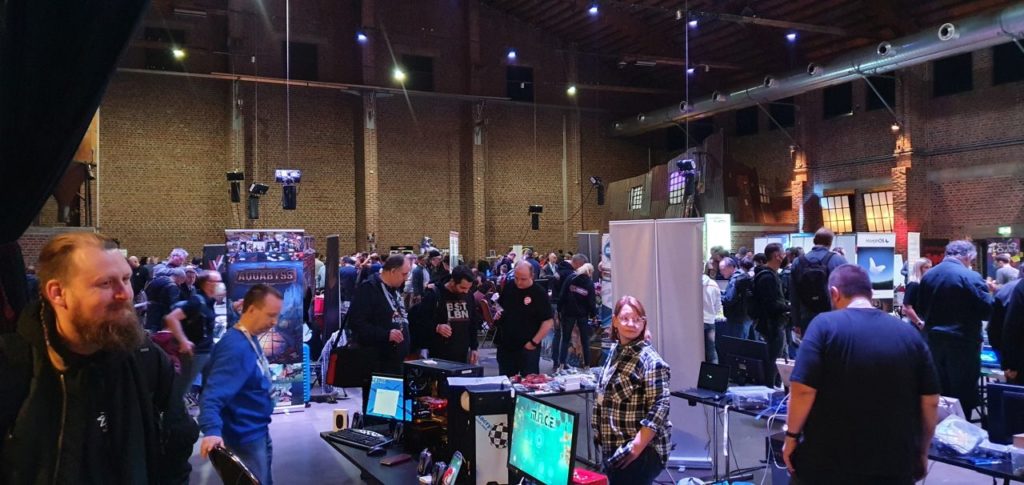
One thing I love about such parties is that you get an opportunity to meet, in person, people you only know from the online world. So it was nice to finally put actual faces to names and nicknames from the AmigaOS4 forums: George ‘Walkero’ Sokianos, David ‘Skateman’ Koelman, Paul ‘Sananaman’ Koster and others. Some of the platform’s movers and shakers were present, too. I exchanged a few words with A-EON’s Trevor Dickinson (always the social animal!), I played a bit of Tower 57 on Daniel Müssener’s AmigaOne, and I’m sure a few jaws dropped when Mike Battilana (Amiga Corporation and Cloanto) was spotted in conversation with Ben Hermans of Hyperion. I wonder what the unlikely pair were talking about? Weather, or their never-ending court case?
Of course, Next-Generation Amiga computers represented a minority at the Amiga37. The event was largely about Classic systems, which were on display in numerous shapes and forms. Original Commodore hardware sat next to modern machines based on emulation or FPGA reimplementation; professional production mingled with DIY. The event oscillated between a computer fair, a games convention and a flea market in the most natural manner. It had a bit of everything for everybody, including Commodore 64 fans. For those who had no idea how big the retro thing had become, this show must have been an eye-opening experience!

Arguably, the most popular stand was that of the Apollo Computer team. It was also the most professional-looking, in my opinion. The guys put up quite a display to promote their computers and accelerators, with colourful roll-up banners, company t-shirts and, of course, a battery of Vampire V4 Standalone systems running games to play. Not that I would buy one myself (as a non-gamer I’m rather hard to please) but the team definitely deserves a mention for their stylish and well thought-out presentation.

Rambling around the hall, I also stopped by the iMica Ltd. stand and had a brief chat with the company’s owner Stephen Jones. I’d had my eye on his Checkmate cases for some time, thinking about getting the smaller Checkmate 1500 Mini for the upcoming AmigaOne A1222. But I decided against it, seeing that the case is actually quite large for a Mini-ITX board. It’s funny how misleading pictures can be because the case looks tiny in promotional materials, while in reality it’s not much smaller than its larger brother, the Micro-ATX sized Checkmate 1500 Plus. Two of these cases had a Checkmate Monitor prototype sitting on top of them. Although still waiting for their Kickstarter launch, the prototypes were fully working and attracting a good deal of interest – Stephen answered questions all the time! I normally wouldn’t care much about an LCD monitor that tries to look like a CRT model of yesteryear, but this monitor has one great thing about it. There’s an opening at the back of the chassis in which you can install a MiSTer or a Raspberry Pi board, turning the setup into an iMac-style computer-in-a-monitor solution. I can’t think of a more practical system to take to Amiga parties, so I’m sure Stephen will sell a lot of these.
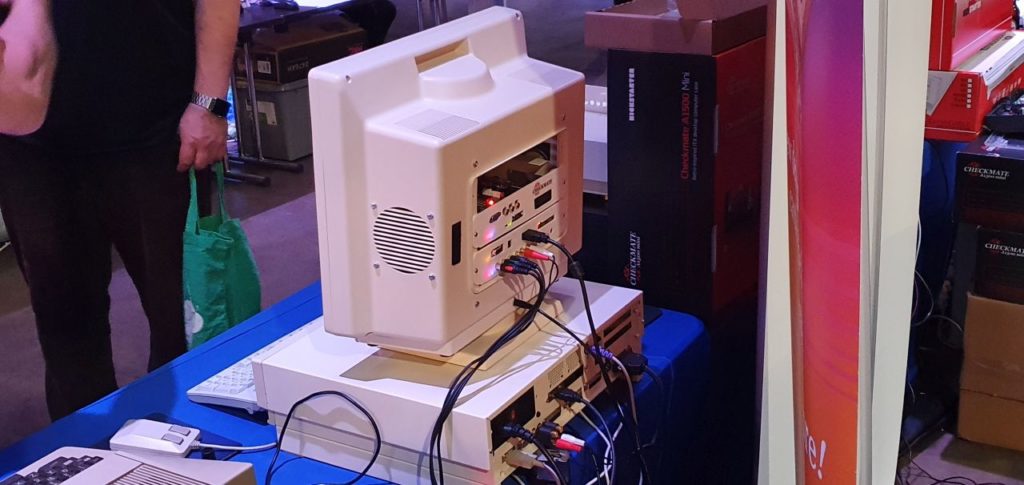
With slightly different Amiga inclinations, our two-man crew spent part of the event separately, each of us going after the things he enjoys. A few times in the afternoon we would reunite upstairs at the Red Crocodile for interviews we wanted to see. We caught a bit of Amiga Bill’s Community Meet-Up, and although the show was mainly about thanking Bill’s fans and supporters, it was refreshing to experience the man’s infectious enthusiasm and positive energy. Some of the interviews were held in German, a language we’d only mastered to the point of being able to order a beer, so we skipped them and instead ordered a beer downstairs. An interview we had been looking forward to was that with former Team17 members Martyn Brown and Andreas Tadic. I hadn’t played many of their games back in the day, but Human Factor used to be a big fan and wanted to see his teenage years’ heroes (even more so now that he works in the gaming industry as well). As for me, I’ve always admired people who managed to turn their Amiga hobby into a way to make a living, and I really enjoyed listening to Martyn and Andreas sharing their stories from behind the scenes.

Having already seen most of what was happening downstairs, we decided to stay at the Red Crocodile to watch whatever was next on the programme. The online video interview with Jim Collas was apparently a last-minute addition because it wasn’t listed in the original schedule published in the Amiga Future Special. It was a welcome surprise, though. Jim talked about his bumpy ride as director of Amiga Technologies, and mentioned some of the opportunities lost during the Gateway years. His answers were open and sincere, and it seemed that his past involvement with the Amiga and its community had left some impact, because his voice was clearly getting emotional towards the end of the interview. Although Collas embodies one of Amiga’s many failures, he certainly made an impression on the audience, and the eventual round of applause was more than just a polite courtesy.
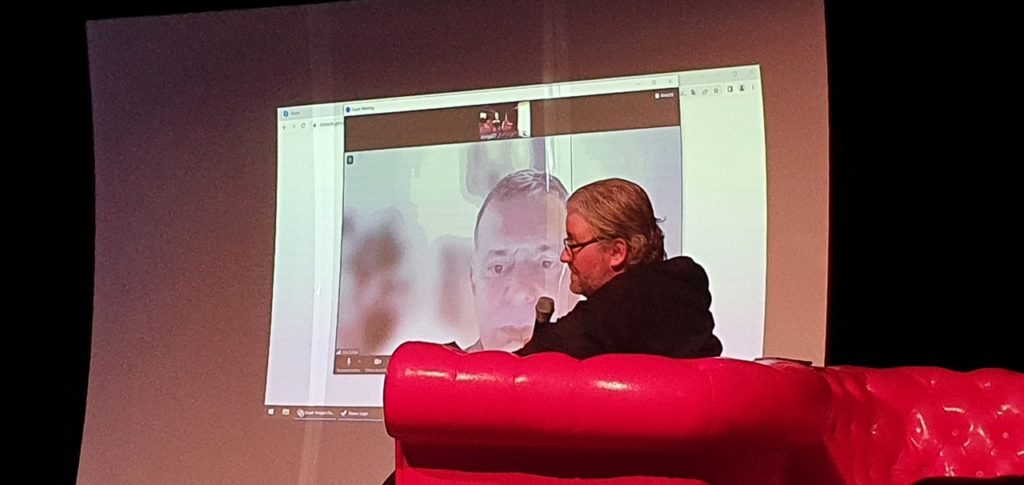
The final item on the list of talks scheduled for Saturday was the announcement of the Amiga Community Award winner. I was among the nominees, so one half of me thought it advisable to stay and wait for the results. But it was already 6pm and hunger was getting the better of us, so I made a realistic assessment of my chances and suggested that we better go get something to eat, and take a rest at the hotel before we head for the Setpatch Aftershow Party.
Mönchengladbach is a city of about 260,000 inhabitants, so you can imagine that it can get quite busy on a Saturday night. When our taxi dropped us in the centre shortly before 10pm, the streets were literally swarming with people! It took us some time to find the Projekt 42 nightclub, mainly because we couldn’t see any signs or banners betraying its existence. Finally we spotted an inflatable boing-ball hanging above the entrance door, and a queue of what we presumed to be Amigans patiently waiting for the club to open.

When we got inside, the club was shaking to the sound of DJ music and the staff at the bar were already busy serving drinks. After about thirty minutes of dubstep torture we noticed that there was no stage or instrument rigs around, and we got a suspicion that we were in the wrong place. And of course, there was another room at the opposite end of the club, which we discovered just in time because the Chris Hülsbeck concert was about to begin. The games music legend performed alongside his collaborator Patrick Nevian on keyboards, Chris himself controlled a very efficient setup that consisted of a small MIDI keyboard connected to a tablet running a software sampler or similar. The gig didn’t disappoint, they played the usual hits and some more, but of course it felt a little static: two guys on keys can hardly bring the club down.
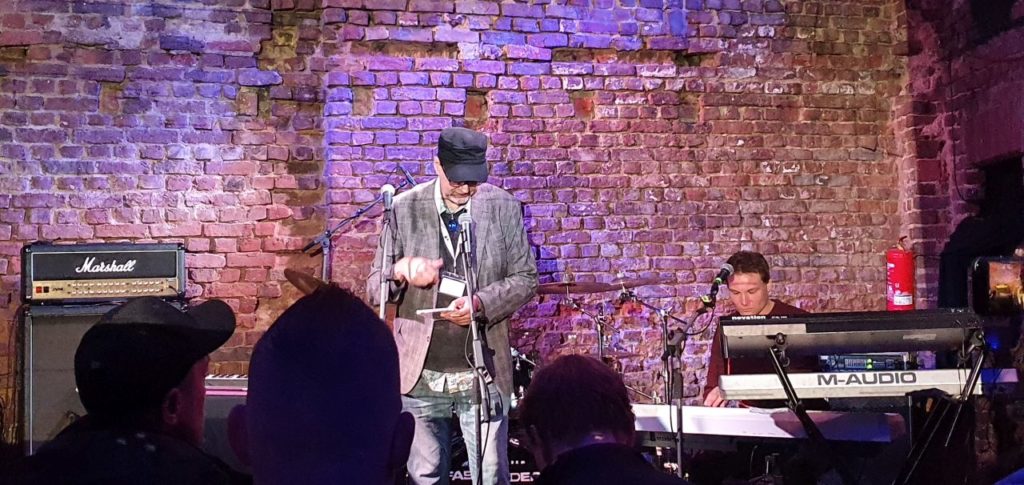
As a hard-rock outfit, the FastLoaders were a different kettle of fish of course. The band from Bergen rose to subcultural fame thanks to their energetic cover versions of the Last Ninja game soundtracks. Since their breakthrough Ninja Musicology triple album, released in 2016, they have covered many more Commodore 64 as well as Amiga classics. FastLoaders concerts usually combine the best of both worlds, but this time their performance was based entirely on the Amiga Rocks album. Quite understandable given the occasion, but we couldn’t help feeling a little disappointed that none of the great Ninja music made it onto the set list. Anyway, they played enough hits to rock the audience and create a fantastic atmosphere: Shadow of the Beast, R-Type, Turrican II, Lost Patrol, you name it. But I think most will agree with me that the highpoint of the gig was when Jon Hare, the original author of the Cannon Fodder music, climbed onto the stage to play and sing alongside the band. Together they played “Narcissus” (the game’s melancholic menu theme) as well as the famous intro music – and we all sang along that “war has never been so much fun!”
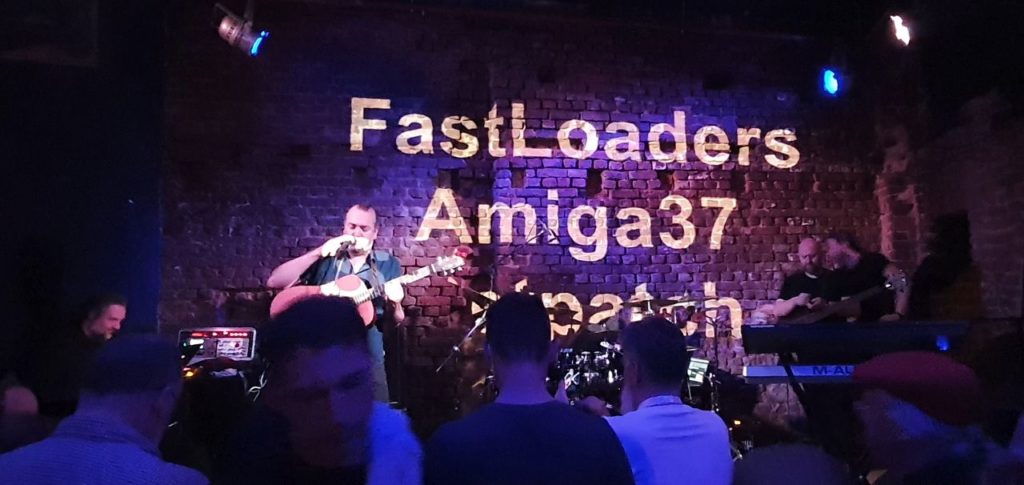
The concert ended well past 1am, and although it left us highly energized, we knew we had to leave the club instead of staying for more fun. The prospect of our journey back (which would again take the whole day) was looming above us, and we simply needed to get some sleep to make our travel safe. We were sorry we couldn’t attend the Sunday programme, but our in-and-out visit was still an unforgettable experience. Amiga37 was a well-organized event full of interesting moments, and I’m really glad we went although we could only give it one day. The experience has worked wonders for my party-going appetite, so chances are I’ll meet you at another Amiga get-together very soon!

Pingback: All I want for Christmas is Rave | Rear Window